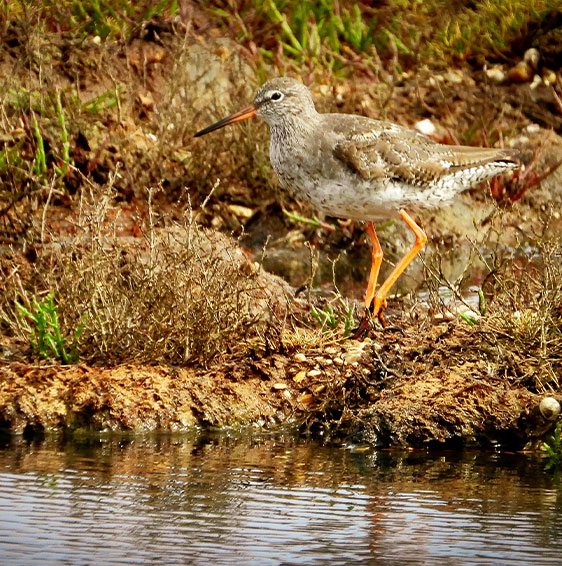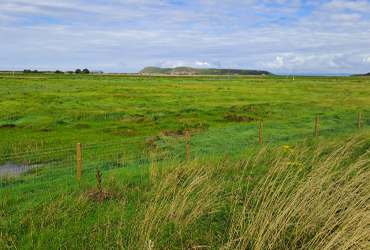- Home
- Our purpose
- Increased biodiversity
- Restoring saltmarsh at Bleadon Levels
Creating saltmarsh at Bleadon Levels
In 2000, we created 16 hectares of saltmarsh at Bleadon Levels on land previously used for growing maize.
Two deliberate breaches in the old Victorian sea defence were made and a network of tidal creeks excavated.
A new, bigger sea-defence structure was created inland and the area of land between the river Axe and the new sea defence (the new intertidal zone), developed into saltmarsh habitat.
Saltmarshes are vitally important habitats, providing a range of environmental benefits including biodiversity, carbon storage and flood protection.
Commonly found along sheltered coastlines and river estuaries, they are home to an array of salt-tolerant plants and animals, not found in other habitats.
Wildlife in the Severn Estuary
The Severn Estuary, in particular, supports an abundance of wildlife so rich that it is protected by international law.
Over-wintering and migrating birds such as redshank, dunlin, curlew and wigeon gather in the estuary to feed on the abundant invertebrates found on the mudflats and marshes exposed at low tide.
Many of these bird species – including some such as the redshank that are suffering a decline in numbers nationally – use the area as a re-fuelling stop-over on epic migrations that span thousands of miles.
When the tide comes in, the mudflats are covered by water and the birds move onto the saltmarshes where they can rest, camouflaged, or grouped together in a roosting flock.

How the saltmarsh is performing at Bleadon Levels
Since its creation, the Bleadon Levels saltmarsh has seen salt-tolerant plant species such as sea thrift (Armeria maritima), sea milkwort (Glaux maritima) and the locally-rare sea clover (Trifolium squamosum) establish themselves.
As this new vegetation has established, it traps more sediment brought in by the high tides, burying the carbon stored in those plants and raising the level of the ground over time.
It is estimated that Bleadon Levels has risen over 60 centimetres in height since its creation, locking up many tonnes of carbon dioxide from the atmosphere in the process.
This ground-raising effect means the whole site has become dryer and is now only likely to flood between two and four times a year.
While this is a normal process for sheltered saltmarsh habitats, it can lead to a loss of biodiversity within specialised plant communities if no appropriate management is carried out.
Many bird species rely on saltmarshes with low-growing vegetation, allowing them to keep watch for predators, such as peregrine falcons and buzzards.
Bleadon Levels is currently dominated by a vigorous grass species called sea couch, which forms a dense mat that prevents wading birds and waterfowl from feeling safe enough to roost.
What we’re doing at Bleadon Levels
Working closely with Natural England and the Environment Agency, we’re introducing cattle grazing onto the saltmarsh for part of the year, beginning in the spring of 2024.
The herd will be a mixture of two traditional hardy breeds – Herefords and Aberdeen Angus – which are both known for their docile temperament and ability to thrive on nutrient-poor pastures, without the need for additional feeding.
Introducing this small herd of hardy cattle will help to keep the vegetation down lower, encouraging rare birds to roost at high tide and encourage flowering plants like sea aster and thrift by halting the spread of sea couch.
The presence of the cattle hooves disturbing the ground will also encourage the germination of new saltmarsh flower seeds and maintain a diverse range of plants that provide food for birds, small mammals, amphibians and bats.
New fencing and water troughs have been installed to ensure the safety of the public, their pets, and livestock.


Next steps at Bleadon Levels
There will be a second period of construction at the site to secure an underground water supply to the new troughs. This is planned to begin in May 2024.
This work will not affect the Bleadon Levels Nature Reserve pools and bird hides but may result in a temporary closure of the England Coast Path during the construction phase.
How you can help
Wading birds are very sensitive to the presence of any animal they perceive as a threat, including dogs and humans.
If disturbed too often, these rare birds will abandon the saltmarsh, increasing the pressure on their species.
By not accessing the old sea wall and the saltmarsh, you can protect rare birds roosting there.
Want to know more?
If you have any questions about our work at Bleadon Levels, please email our CAR team.
